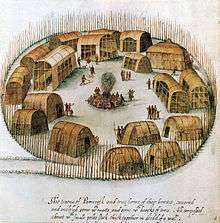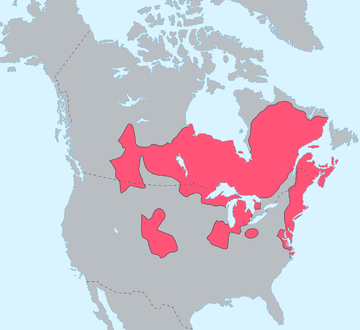Algonquian peoples
The Algonquian are one of the most populous and widespread North American native language groups. Today, thousands of individuals identify with various Algonquian peoples. Historically, the peoples were prominent along the Atlantic Coast and into the interior along the Saint Lawrence River and around the Great Lakes. This grouping consists of the peoples who speak Algonquian languages.[1]


Before Europeans came into contact, most Algonquian settlements lived by hunting and fishing, although quite a few supplemented their diet by cultivating corn, beans and squash (the "Three Sisters"). The Ojibwe cultivated wild rice.[2]
The Algonquians of New England (who spoke Eastern Algonquian) practiced a seasonal economy. The basic social unit was the village: a few hundred people related by a clan kinship structure. Villages were temporary and mobile. The people moved to locations of greatest natural food supply, often breaking into smaller units or gathering as the circumstances required. This custom resulted in a certain degree of cross-tribal mobility, especially in troubled times.[3]
In warm weather, they constructed portable wigwams, a type of hut usually with buckskin doors. In the winter, they erected the more substantial longhouses, in which more than one clan could reside. They cached food supplies in more permanent, semi-subterranean structures.[4]
In the spring, when the fish were spawning, they left the winter camps to build villages at coastal locations and waterfalls. In March, they caught smelt in nets and weirs, moving about in birch bark canoes. In April, they netted alewife, sturgeon and salmon. In May, they caught cod with hook and line in the ocean; and trout, smelt, striped bass and flounder in the estuaries and streams. Putting out to sea, they hunted whales, porpoises, walruses and seals. The women and children gathered scallops, mussels, clams and crabs, all the basis of menus in New England today.[5]
From April through October, natives hunted migratory birds and their eggs: Canada geese, brant, mourning doves and others. In July and August they gathered strawberries, raspberries, blueberries and nuts. In September, they split into small groups and moved up the streams to the forest. There, they hunted beaver, caribou, moose and white-tailed deer.[6]
In December, when the snows began, the people created larger winter camps in sheltered locations, where they built or reconstructed longhouses. February and March were lean times. The tribes in southern New England and other northern latitudes had to rely on cached food. Northerners developed a practice of going hungry for several days at a time. Historians hypothesize that this practice kept the population down, according to Liebig's law of the minimum. Northerners were food gatherers only.[7]
The southern Algonquians of New England relied predominantly on slash and burn agriculture.[8][9][10][11][12][13] They cleared fields by burning for one or two years of cultivation, after which the village moved to another location. This is the reason the English found the region relatively cleared and ready for planting. By using various kinds of native corn (maize), beans and squash, southern New England natives were able to improve their diet to such a degree that their population increased and they reached a density of 287 people per 100 square miles as opposed to 41 in the north.[14]
Scholars estimate that, by the year 1600, the indigenous population of New England had reached 70,000–100,000.[15]
Colonial period
At the time of the first European settlements in North America, Algonquian peoples occupied what is now New Brunswick, and much of what is now Canada east of the Rocky Mountains; what is now New England, New Jersey, southeastern New York, Delaware and down the Atlantic Coast through the Upper South; and around the Great Lakes in present-day Minnesota, Wisconsin, Michigan, Illinois, Indiana and Iowa. The homeland of the Algonquian peoples is not known. At the time of the European arrival, the hegemonic Iroquois Confederacy, based in present-day New York and Pennsylvania, was regularly at war with Algonquian neighbours.[16]
Tribal identities
Canada
The French and later English encountered the Maliseet of present-day Maine, Quebec and New Brunswick; the Abenaki of Quebec, Vermont and New Hampshire; the Mi'kmaw band governments of the Maritimes lived primarily on fishing. Further north are the Betsiamite, Atikamekw, Anishinaabe and Innu/Naskapi. The Beothuk of Newfoundland might have been Algonquians, but as their last known speaker died in the early 19th century, little record of their language or culture remains.[17]
New England area
Colonists in the Massachusetts Bay area first encountered the Wampanoag, Massachusett, Nipmuck, Pennacook, Penobscot, Passamaquoddy, and Quinnipiac. The Mohegan, Pequot, Pocumtuc, Podunk, Tunxis, and Narragansett were based in southern New England. The Abenaki were located in northern New England: present-day Maine, New Hampshire, and Vermont in what became the United States and eastern Quebec in what became Canada. They had established trading relationships with French colonists who settled along the Atlantic coast and what was later called the Saint Lawrence River. The Mahican were located in western New England in the upper Hudson River Valley (around what was developed by Europeans as Albany, New York). These groups practiced agriculture, hunting and fishing.[18]
Midwest
The French encountered Algonquian peoples in this area through their trade and limited colonization of New France along the Mississippi and Ohio rivers. The historic peoples of the Illinois Country were the Shawnee, Illiniwek, Kickapoo, Menominee, Miami, Sauk and Meskwaki. The latter were also known as the Sac and Fox, and later known as the Meskwaki Indians, who lived throughout the present-day Midwest of the United States.[19]
During the nineteenth century, many Native Americans from east of the Mississippi River were displaced over great distances through the United States passage and enforcement of Indian removal legislation; they forced the people west of the Mississippi River to what they designated as Indian Territory. After the US extinguished Indian land claims, this area was admitted as the state of Oklahoma in the early 20th century.[20]
Upper west
Ojibwe/Chippewa, Odawa, Potawatomi, and a variety of Cree groups lived in Upper Peninsula of Michigan, Western Ontario, Wisconsin, Minnesota, and the Canadian Prairies. The Arapaho, Blackfoot and Cheyenne developed as indigenous to the Great Plains.[21]
List of historic Algonquian speaking peoples
- Gros Ventre
- Blackfoot Confederacy
- Kispoko
- Cree
- Croatan
- Meskwaki
- Menominee
- Illinois Confederation
- Lenape
- Mahican
- Maliseet
- Mascouten
- Miami people
- Mi'kmaq
- Missiquoi
- Nanticoke people
- Odawa
- Ojibwe
- Passamaquoddy
- Pennacook
- Penobscot
- Pequot
- Potawatomi
- Powhatan
- Roanoke people
- Sauk people
- Cheyenne
- Hathawekela
- Wampanoag
Footnotes
- Stoltz, Julie Ann (2006). "Book Review of "The Continuance—An Algonquian Peoples Seminar: Selected Research Papers 2000", edited by Shirley Dunn, 2004, New York State Education Department, Albany, New York, 144 pages, $19.95 (paper)". Northeast Historical Archaeology. 35 (1): 201–202. doi:10.22191/neha/vol35/iss1/30. ISSN 0048-0738.
- Raster, Amanda; Hill, Christina Gish (2016-05-24). "The dispute over wild rice: an investigation of treaty agreements and Ojibwe food sovereignty". Agriculture and Human Values. 34 (2): 267–281. doi:10.1007/s10460-016-9703-6. ISSN 0889-048X.
- "The Iroquois are a historically powerful northeast Native American confederacy". www.coursehero.com. Retrieved 2020-04-14.
- "Many Protestants minimize Marys role within Christianity basing their argument". www.coursehero.com. Retrieved 2020-04-14.
- "Many Protestants minimize Marys role within Christianity basing their argument". www.coursehero.com. Retrieved 2020-04-14.
- "Algonquian peoples". www.know.cf. Retrieved 2020-04-14.
- "Algonquian peoples". www.know.cf. Retrieved 2020-04-14.
- Stevenson W. Fletcher, Pennsylvania Agriculture and Country Life 1640-1840 (Harrisburg: Pennsylvania Historical and Museum Commission, 1950), 2, 35-37, 63-65, 124.
- Day, Gordon M. (1953). "The Indian as an Ecological Factor in the Northeastern Forests". Ecology. 34 (2): 329–346. doi:10.2307/1930900. JSTOR 1930900.
- New England and New York areas 1580-1800, 1953. Note: The Lenni Lenape (Delaware) in New Jersey and the Massachuset in Massachusetts used fire in ecosystems
- Russell, Emily W.B. Vegetational Change in Northern New Jersey Since 1500 A.D.: A Palynological, Vegetational and Historical Synthesis, Ph.D. dissertation. New Brunswick, PA: Rutgers University. Author notes on page 8 that Indians often augmented lightning fires. 1979
- Russell, Emily W.B. (1983). "Indian Set Fires in the Forests of the Northeastern United States". Ecology. 64 (1): 78–88. doi:10.2307/1937331. JSTOR 1937331. Author found no strong evidence that Indians purposely burned large areas, but they did burn small areas near their habitation sites. Noted that the Lenna Lenape used fire.
- Gowans, William. "A Brief Description of New York, Formerly Called New Netherland with the Places Thereunto Adjoining, Likewise a Brief Relation of the Customs of the Indians There." New York, NY: 1670. Reprinted in 1937 by the Facsimile Text Society, Columbia University Press, New York. Notes that the Lenni Lenape (Delaware) in New Jersey used fire in ecosystems.
- Cronon, William (1983). Changes in the Land: Indians, Colonists, and the Ecology of New England. New York: Hill and Wang. p. 42. ISBN 978-0-8090-0158-3.
- Cronon, William (1983). Changes in the Land: Indians, Colonists, and the Ecology of New England. New York: Hill and Wang. p. 42. ISBN 978-0-8090-0158-3.
- "Algonquian Peoples – Legends of America". www.legendsofamerica.com. Retrieved 2020-04-14.
- (PDF) https://ago.vermont.gov/wp-content/uploads/2018/02/RESPONSE-to-Abenaki-Petition-Jan2003v.pdf. Missing or empty
|title=(help) - "Algonquin Indians". AAA Native Arts. Retrieved 2020-04-14.
- "History | Meskwaki Nation". Retrieved 2020-04-14.
- "History | Meskwaki Nation". Retrieved 2020-04-14.
- "Ojibwe". www.tolatsga.org. Retrieved 2020-04-14.
Further reading
- Melissa Otis, Rural Indigenousness: A History of Iroquoian and Algonquian Peoples of the Adirondacks. Syracuse, NY: Syracuse University Press, 2018.